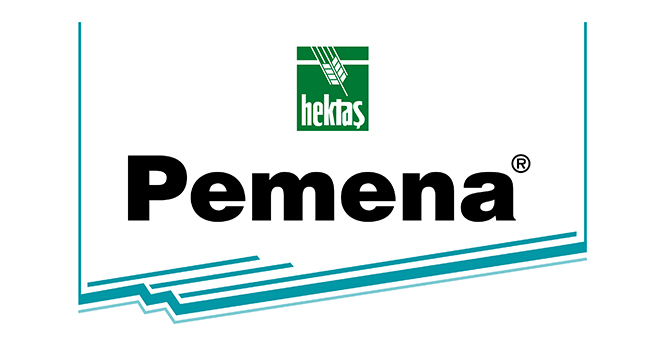
PEMENA®
Active Substance : 100 g/l Pyriproxyfen
Formulation : EC (Emulsion concentrate)
Method Of Application
PREPARING THE PLANT PROTECTION PRODUCT FOR APPLICATION:
The plant protection product calculated over the recommended dose is first mixed with some water in a separate container. The tank of the application machine is half filled with water. While the mixer of the machine is in operation, the mixture is added to the tank. Continuing to mix, the tank is completed with water. The mixing process is continued until the application is completed. Use the prepared mixture on the same day.
CALIBRATION: The application machine must be calibrated before the application. The amount of mixture to be given to a certain area should be adjusted to provide a good coating in applications. Applications should be made at cool times of the day, in windless or slightly windy weather conditions.
Usage
USAGE OF THE PLANT PROTECTION PRODUCT:
Against tobacco whitefly in tomato (greenhouse), eggplant, pepper (greenhouse), cucumber (greenhouse) and zucchini (greenhouse), the area found to be infected with whitefly is entered from the diagonal direction. Every five steps, 50 leaves are collected from the lower, middle and upper leaves. Chemical control is applied when there are 5 larvae + pupa per leaf.
Applications against mulberry crustacean in peach are applied against first and second progeny. It is applied in two applications, at the first larva emergence and 20 days after that. However, it should be taken into account that some peach varieties have come to the harvest period in the second generation.
Considering the density of whitefly against tobacco whitefly in cotton, control should be started when there are 10 larvae + pupae per leaf.
The application time against olive black cochlea in olives is determined according to the active larvae emergence. For this purpose, in the gardens where the application will be made, the females with eggs belonging to that year on the shoots of 20-25 cm from 4 sides of the tree in a number to represent the garden are checked and active larvae hatching from the eggs is determined. The first application is made in the period when 50% of the eggs are opened, and the second application is made in the period when 90% of the eggs are opened.
Against olive crustacean in olives, no application should be made against the first generation of the pest, except in very high populations. In the second generation of the pest, the density of the pest and the rate of parasitism in the garden should be taken into account. The application is made in such a way that the leaves and fruits can be wetted when 50% of the eggs are hatched and the first stage larvae are in the majority. This app is enough.
It is applied when the number of contaminated teats against bloody honeydew in figs exceeds 5%, and when more than 90% of the cosnium is opened. No application is made 1 week before the date of sowing and within 10 days following the sowing date. One application is enough. The application should preferably be done at the end of harvest in mid-October.
If the total number of eggs, larvae and pupae against pomegranate whitefly is 10 or more per leaf, it is decided to apply.
The application should be made to the first instar larvae before the egg laying period (mid-April and the first week of May) or during the period when the cosnill’s egg laying is at its highest.
INFORMATION ON RESISTANCE: The plant protection product named Pemena® is an insecticide classified as Group 7C according to its mechanism of action. Repeated applications of plant protection products with the same mechanism of action encourage the development of resistance. Therefore, in order to delay the development of resistance, do not apply Pemena® more than twice in the same production season. In cases where the application must be repeated, pay attention to the use of plant protection products with a different mechanism of action (except for Group 7C).
Detailed Table Information
| Plant Name | Harmful Organism Name | Dosage of Use | Time Between Last Spray and Harvest |
|---|---|---|---|
| Tomatoes (Greenhouse) | White fly (Bemisia tabaci) | 50 ml/100 L water (larva) | 1 day |
| Peach | White peach scale (Pseudaulacaspis pentagona) | 50 ml/100 L water (larva) | 14 day |
| Aubergine | White fly (Bemisia tabaci) | 50 ml/da (larva) | 3 day |
| Pepper (Greenhouse) | White fly (Bemisia tabaci) | 50 ml/100 L water (larva) | 3 day |
| Cotton | White fly (Bemisia tabaci) | 50 ml/da (larva) | 28 day |
| Olive | Black scale (Saissetia oleae), Olive parlatoria scale (Parlatoria oleae) | 50 ml/100 L water (larva) | 14 day |
| Cucumber (Greenhouse) | White fly (Bemisia tabaci) | 50 ml/100 L water (larva) | 3 day |
| Courgette (Greenhouse) | White fly (Bemisia tabaci) | 50 ml/100 L water (larva) | 1 day |
| Fig | Bloody honeydew (Ceroplastes rusci) | 50 ml/100 L water (larva) | 3 day |
| Pomegranate | Pomegranate White fly (Siphoninus phillyreae) | 50 ml/100 L water (larva) | 3 day |
| Rose | Rose Kosnille (Parthenolecanium spp.) | 50 ml/100 L water (larva) | 3 day |
